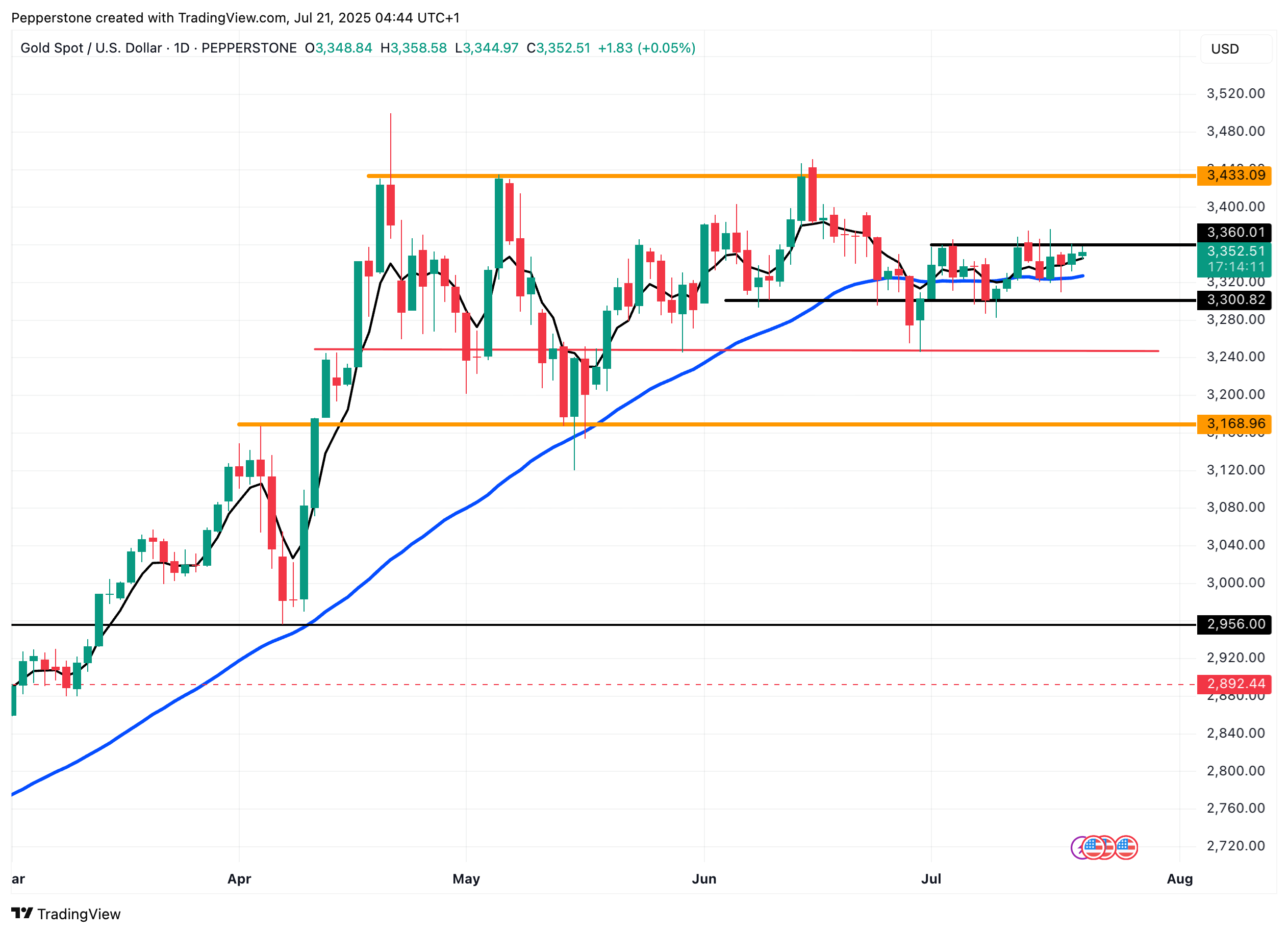- English
- عربي
Gold Outlook: Bulls and Bears Deadlocked, Awaiting a Catalyst
.jpg)
Gold has remained range-bound in recent sessions. Solid US data in June - including strong retail sales and resilient consumer confidence - along with slightly elevated CPI readings, have prompted the Fed to maintain a cautious tone. At the same time, a stronger dollar and surging US equities have temporarily dulled gold’s appeal. However, lingering concerns about the Fed’s independence and rising geopolitical risks have provided support, limiting the chances of a sharp pullback.

From a technical perspective, gold appears tightly locked between $3,300 and $3,360, despite repeated attempts by bulls and bears to break out. Price action near the 50-day moving average is worth watching. If that support gives way, prices could retreat toward $3,300 or even test the May-June lows around $3,250. On the upside, resistance remains firm at $3,360 and $3,400.
Tariff Tensions and Policy Posturing Shape Safe-Haven Demand
The lack of a clear trend in gold stems from a constant mix of opposing forces - neither side strong enough to dominate the market narrative.
Take the latest round of tariff headlines: with the August 1 deadline approaching, the Trump administration has announced sweeping tariffs - ranging from 19% to 36% - on several Southeast Asian countries, a 50% levy on Brazil, and 15%-20% on EU goods. Over 100 smaller economies would face a uniform rate slightly above 10%.
While these measures could disrupt supply chains and alter the global competitive landscape if fully enforced, most market participants still interpret them as part of a familiar “pressure-then-negotiate” playbook. Even so, the EU is reportedly preparing a retaliatory tariff list targeting US service, in case talks break down. This lingering uncertainty has prompted many investors to maintain gold positions as a hedge. That said, the recent strength of the dollar has diverted some safe-haven flows into greenback assets, slightly weakening gold’s support.
Another driver has been speculation over the Fed’s policy independence. While Trump continues to find new angles to pressure Chair Powell, markets still consider it unlikely that Powell will be replaced early. Traders are not ignoring the risk - but without a clear timeline for a leadership change, there’s little urgency to add hedges via gold.
Geopolitical Tensions and Economic Data Keep Gold Supported
For gold bulls, geopolitical uncertainty remains a key pillar of support. The Russia-Ukraine war drags on, with deeper US involvement. At the same time, ceasefire talks in Gaza are at a standstill. Any sudden escalation in either region could push demand sharply higher for gold as a non-sovereign safe-haven asset.
Despite these risks, the US economy continues to show resilience. June retail sales exceeded expectations across the board. Initial jobless claims declined, housing starts and permits are recovering, and consumer sentiment - measured by the University of Michigan survey - has also improved. Meanwhile, the latest CPI data surprised to the upside, with both headline and core inflation hitting year-to-date highs.
This has reinforced the Fed’s patient approach. Markets still expect two rate cuts by year-end, and since recent data hasn’t materially altered rate expectations, gold has remained relatively calm.
Over the long term, the fundamental case for gold remains intact. Central banks continue to buy, and the US fiscal situation remains shaky - both factors that underpin price floors. However, recent developments like Nvidia’s approval to export H20 chips to China have lifted equities once again, leading to near-term outflows from the gold market.
Range Likely to Hold, Watch Trade Talks and Earnings
Overall, gold’s continued range-bound movement between $3,300 and $3,360 signals a market in equilibrium, with bullish and bearish factors effectively canceling each other out. While tariff headlines and macro data continue to stir short-term volatility, they have yet to push gold into a definitive trend. Unless we see a confirmed shake-up at the Fed, a sharp equity market correction, or a sudden geopolitical flare-up, gold is likely to stay in consolidation mode.
Heading into August, attention will stay on US trade negotiations - particularly with the EU and China. The July 24 EU-China Summit in Beijing could be pivotal. Discussions are expected to cover trade tensions, geopolitical issues, and mutual trust. If both sides show signs of compromise, it could ease risk-off sentiment and weigh on gold. Conversely, if rhetoric intensifies, gold could regain support.
Meanwhile, Google (Alphabet), Tesla, and Intel are all set to report earnings after market close on Wednesday, alongside expected AI policy updates from Trump. If tech earnings beat expectations and AI policies boost sentiment in growth stocks, renewed appetite for risk assets may further dampen gold’s near-term performance.
The material provided here has not been prepared in accordance with legal requirements designed to promote the independence of investment research and as such is considered to be a marketing communication. Whilst it is not subject to any prohibition on dealing ahead of the dissemination of investment research we will not seek to take any advantage before providing it to our clients.
Pepperstone doesn’t represent that the material provided here is accurate, current or complete, and therefore shouldn’t be relied upon as such. The information, whether from a third party or not, isn’t to be considered as a recommendation; or an offer to buy or sell; or the solicitation of an offer to buy or sell any security, financial product or instrument; or to participate in any particular trading strategy. It does not take into account readers’ financial situation or investment objectives. We advise any readers of this content to seek their own advice. Without the approval of Pepperstone, reproduction or redistribution of this information isn’t permitted.